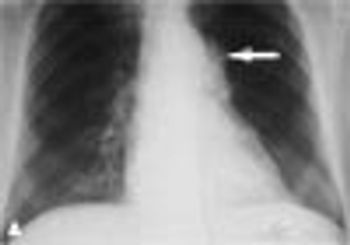
GHENT, Belgium ? Inexpensive pedometers can't be counted on to keep step accurately, researchers reported here, and may send the wrong message in fitness-walking programs

GHENT, Belgium ? Inexpensive pedometers can't be counted on to keep step accurately, researchers reported here, and may send the wrong message in fitness-walking programs

ROCHESTER, Minn. - Heartburn is mainly a phenomenon of western culture, according to a systematic review of gastroesophageal reflux disease (GERD).

BOSTON ? High levels of retinol binding protein 4 (RBP4), which transports vitamin A as its main job, may be an early warning sign for insulin resistance and type 2 diabetes, according to researchers here.

HOUSTON - Unexplained vision loss may be related to vitamin A deficiency in patients with a history of intestinal or bariatric surgery, no matter how long ago, according to ophthalmologists here.

WASHINGTON - Lorcaserin, an investigational drug for the treatment of obesity, was successful at producing weight loss ranging between four and 7.9 pounds (1.8 to 3.6 kg) in a 12-week study, reported investigators here.

WASHINGTON - Liraglutide, an investigational injectable drug for type 2 diabetes, has produced significant decreases in HbA1c levels, as well as significant and sustained weight loss, according to phase 2 studies.

OAKLAND, Calif. ? Coffee may help protect the livers of heavy alcohol drinkers. In a cohort study of Kaiser Permanente members, drinking one to three cups of coffee a day was associated with a 40% decrease in the risk of alcoholic cirrhosis versus drinking less than one cup.

ROCKVILLE, Md. - The FDA today approved Wellbutrin XL (bupropion extended release) for prevention of major depressive episodes in patients with a history of seasonal affective disorder (SAD). It is the first drug approved for SAD.

WASHINGTON ? Januvia (sitagliptin), an investigational oral agent for type 2 diabetes, appears to be effective when given as a monotherapy or as an adjunct to Glucophage (metformin) or Actos (pioglitazone), reported researchers here.

WASHINGTON ? Antidepressant medications appears to further increase the risk of developing type 2 diabetes in those with impaired glucose tolerance, researchers reported here.

WASHINGTON ? Preeclampsia is an independent risk marker for type 2 diabetes, even when gestational diabetes is taken into account, reported researchers here today.

ROCHESTER, Minn. ?Treating obese patients with chronic hepatitis C infection with a diet-and-exercise regimen could improve both their overall health and their response to antiviral therapies, researchers suggest.

A 22-year-old woman presents with fever and malaise of1 month’s duration. About 3 weeks earlier she went to theemergency department. Erythromycin was prescribed,and the patient was told to seek medical attention if hercondition did not improve. Since that time, her healthhas worsened, the fever has continued, and she has lostweight. She says she has had painful areas on her handsand feet but no rash.

Patients with psychiatric disordersoften present a diagnostic challenge-even for psychiatrists. Their demeanormay not readily reveal the nature orseverity of the problem. Nevertheless,there are clues that can help you sortthrough the differential and arrive atthe correct diagnosis.

The authors describe a woman who presented with severe pulmonary hypertension. A cardiopulmonary cause was initially sought, but thyrotoxicosis was the underlying cause.

Diabetic nephropathy, the leading cause of end-stage renal disease (ESRD) in the United States, affects 20% to 30% of patients with diabetes. Early diagnosis and aggressive treatment may delay the progression of kidney disease.

ABSTRACT: The key features of polycystic ovary syndrome (PCOS) are menstrual bleeding disturbances caused by chronic oligoovulation or anovulation and clinical or biochemical hyperandrogenism. The finding of polycystic ovaries on ultrasonography alone has limited predictive value. Obesity often coexists with PCOS and can exacerbate metabolic disturbances, particularly insulin resistance, but it is not a diagnostic finding. Laboratory results can rule out other conditions in the differential, such as an androgen- producing neoplasm, hypothyroidism, and late-onset congenital adrenal hyperplasia.

The secret to weight management is to communicate the answers to patients' questions about diet in a way that motivates them to apply the information. Here are some motivational strategies that may be effective.

The treatment of polycystic ovary syndrome (PCOS) is based on the patient's presenting symptoms and any significant abnormal findings. Symptoms can be managed with combined oral contraceptives (OCs), insulin-sensitizing agents, antiandrogens, and medications used to induce ovulation.

A long list of foodstuffs have been blamed for the nation's increasingly widespread weight and health problems. Now the spotlight has been turned not on what Americans eat--but on what they drink.

A 68-year-old man presented with diplopia, progressive dyspnea, leg swelling, weakness, night sweats, and a 9-kg (20-lb) weight loss. He had been healthy up until 2 weeks earlier, when the symptoms started. The patient's medical, social, and family history was noncontributory.

BOSTON - Symptoms of gastroesophageal reflux disease increase progressively with increasing body mass indices, even among normal-weight women, according to data from the Nurses' Health Study.

PAWTUCKET, R.I. - Patients may not be getting the message about the heart risks associated with dyslipidemia when the message is delivered by-the-numbers, according to researchers here.

My 46-year-old patient had a fasting plasma glucose level of 115 mg/dL; a followupfasting plasma glucose level was 116 mg/dL.

A 52-year-old man complains of right knee pain that hasbeen increasing steadily for several weeks. Two years earlierhe underwent a total arthroplasty of the same knee to treatsevere osteoarthritis secondary to a meniscal injury. He hasno history of recent trauma or increased activity.